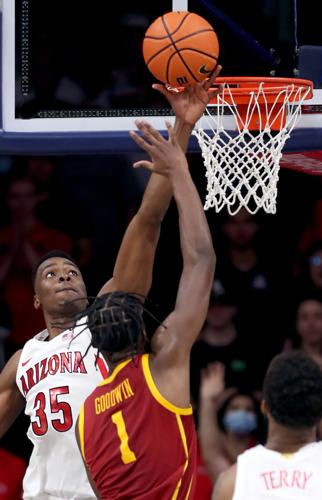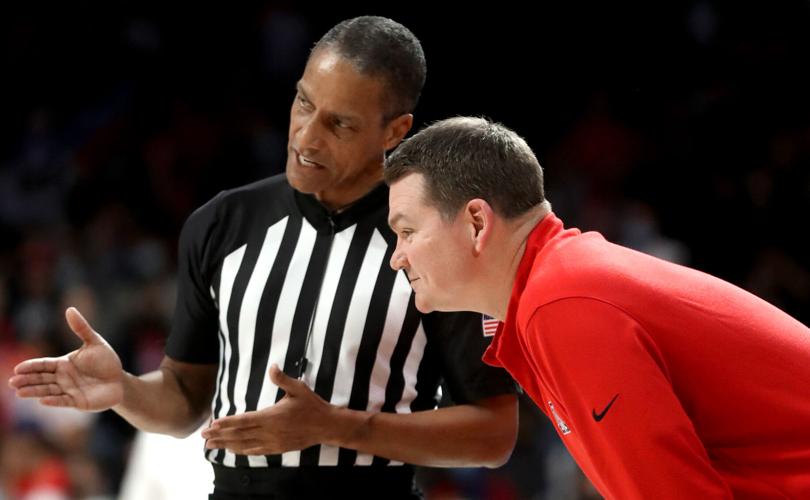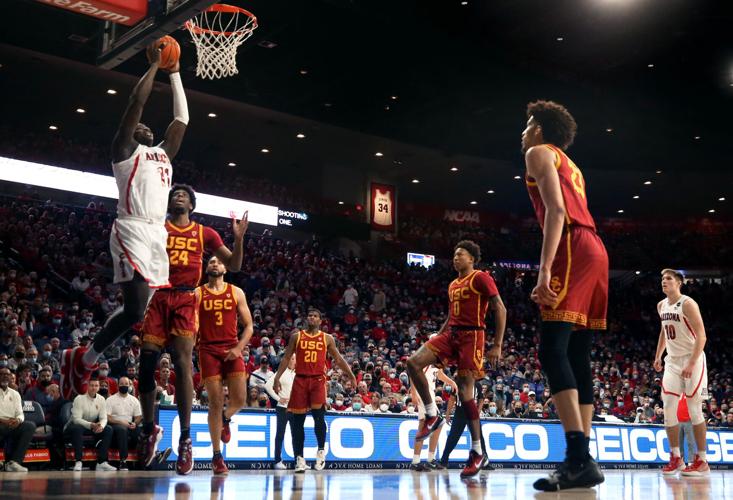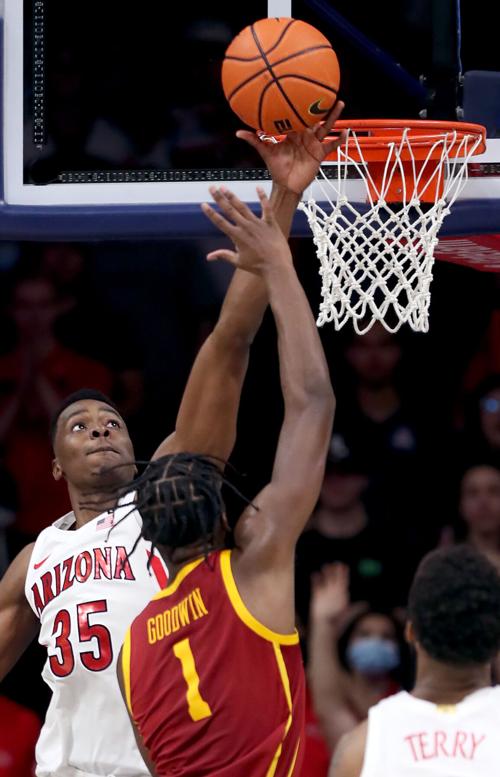Take a guess how many 7-footers have played Pac-12 basketball since Arizona joined the league. You won’t get it. You won’t come close.
I would’ve guessed 30. It’s 81.
Not all of them played to an elevated level. Since 2009, USC has put 7-footers Mamadou Diarra, Davis Rozitis, Dewayne Dedmon, James Blasczyk, D.J. Haley, Evan Mobley and Omar Oraby on the court.
Ever hear of them?
Only Mobley averaged more than seven points and became an NBA draft pick, but the pursuit of 7-footers — the chase for size — continues more than ever in college basketball.
On Saturday, we found out why. In the final six minutes of Arizona’s improbable 72-63 comeback victory over USC, 7-foot 1-inch Christian Koloko played like a cross between Loren Woods and Deandre Ayton, the two most successful 7-foot centers in Wildcat history.
There’s big and then there’s BIG, which is what Koloko did when his team absolutely, positively had to find someone to dig them out of a six-point, clock-ticking hole.
Here’s what shows up in the box score from those final six minutes:
Koloko blocked a shot leading to a 3-pointer by Kerr Kriisa.
Koloko grabbed a rebound that led to a fast break basket by Azoulas Tubelis.
Koloko scored on an offensive rebound/put-back flip-hook for a 62-60 lead.
Koloko blocked a shot and then scored on a turn-around flipper for a 66-62 lead.
Game ball, please.
“All those shots around the rim suddenly got pretty tough,” said Arizona coach Tommy Lloyd.
When USC showed up at McKale, the Trojans’ tallest (and best) player was 6-11 Isaiah Mobley, who might truly be a full 7-feet. When Mobley stood next to Koloko and 7-foot Oumar Ballo, the difference was miniscule.
According to Kenpom.com, Arizona and USC rank No. 2 and No. 3 in average height nationally, which is a factor that Lloyd appreciates as much as the analytics people. Arizona won all the big man stats Saturday:
Points in the paint: Arizona 42, USC 28.
Layups: Arizona 11, USC 8.
Blocks: Arizona 6, USC 4.
Intimidations: Arizona 10, USC about 1.
Arizona point guard Kerr Kriisa displayed expert crunch-time instincts by getting the ball to Koloko when it mattered most. Kerr noticed that Koloko wasn’t included in a recent list of the nation’s 10 leading big men for 2021-22 and didn’t like it.
“We all trust our bigs down low, especially at the end of games,” said Kriisa. “Why not give them the chance to finish up?”

Arizona coach Tommy Lloyd said he's been impressed with the way center Oumar Ballo has played since Azoulas Tubelis suffered an ankle injury two weeks ago.
This 7-foot stuff is news because Lloyd is sometimes playing both Koloko and Ballo together, sometimes in four- or five-minute stretches, as he did in the first half Saturday. It changes the dynamics of an early-season built-for-speed team into one of a rim protector like few in the Top 25.
For a month or so, I would’ve nominated Koloko as the most improved player in college basketball. Now I might give Ballo the vote.
Ballo was only credited with one blocked shot Saturday, but in the middle of the first half he intimidated three USC near-the-rim shots, all of them bouncing harmlessly into Arizona’s hands.
Arizona has deployed nine 7-footers since Canyon del Oro High School state championship brothers Mark and Brian Jung were recruited to Arizona in the late 1970s. Although the Jung brothers did not become star-level players at Arizona – both did their best work after transferring to Northwestern and Colorado State – their 7-foot successors have all been significant UA contributors.
Woods, Ayton, Lauri Markkanen, Kaleb Tarczewski and Ed Stokes all played on Pac-12 championship teams. Koloko and Ballo appear to be headed in a similar direction.

USC’s defense watches as Arizona center Oumar Ballo jams home a dunk during Saturday’s game.
Ballo was viewed as a long-range project after he transferred from Gonzaga. In the Zags’ final 17 games last year he only played 25 total minutes. But his trajectory at Arizona changed when Azoulas Tubelis was injured last month, creating opportunity.
Ballo? Ready.
“Since that injury, Oumar has taken off,” said Lloyd.
No one (thank goodness) has taken to calling Koloko and Ballo the “Twin Towers,” which was a cliche from the ‘80s and ‘90s that more than ran its course. But they are not the only 7-foot teammates in the Pac-12 to contribute strongly to Top 25 teams.
Stanford climbed to No. 1 in 2000-01, 31-3 overall, when 7-footers Jason and Jarron Collins and Curtis Borchardt combined with All-American shooter Casey Jacobsen to win the Pac-10 with a 16-2 record, finishing ahead of Arizona’s Final Four team.
Washington became a Sweet 16 team in the mid-90s when all-conference 7-footer Todd MacCullough and 7-foot Patrick Femering combined to average 24 points and 15 rebounds a game.
The last time the Pac-12 had a pair of much-feared 7-footers was 2007-08, when Stanford twins Robin and Brook Lopez combined for 29 points and 13 rebounds per game as the last truly formidable Cardinal team won 28 games and reached the Sweet 16.
Now come Koloko and Ballo. On Saturday they combined for 14 points and 12 rebounds. Advantage, Arizona.







